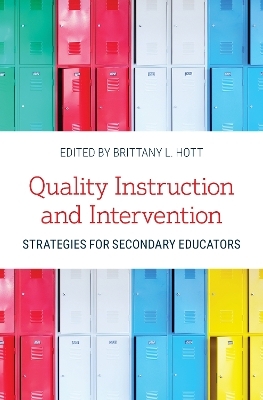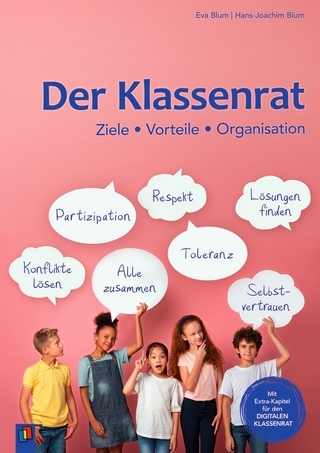
Quality Instruction and Intervention Strategies for Secondary Educators
Rowman & Littlefield (Verlag)
978-1-5381-4377-3 (ISBN)
Quality Instruction and Intervention: Strategies for Secondary Educators offers an introduction to quality general education instruction followed by the most up to date evidence-based interventions. Two dedicated chapters, authored by leading content and strategy experts in the field, are devoted to academic (reading, mathematics, writing, content areas), classroom management, and study skills. The first chapter focuses on quality instruction with content specialists as lead authors and interventionists supporting. The second chapter focuses on effective intervention with the interventionists taking the lead author roles and content specialists supporting. This unique method bridges the gap between quality instruction and effective intervention—an often over looked component of education. The last chapter of the text includes a comprehensive list of low or no cost materials to support implementation of instructional practices and interventions. After reading, educators will be able to describe the components of effective instruction and intervention in each of the content areas, access empirically validated materials, and locate resources for continued learning.
Contributors Julie Atwood, Brittany Batton, B. Keith Ben-Hanania Lenz, Glenna Billingsley, Brennan Chandler, Amber Curlee, Erica Fry, Dave Furjanic, Nicholas A. Gage, Ambra L. Green, Angela Green, Brittany L. Hott, Jasmine Justus-McDowell, Sami Khan, Tim Lintner, Ashley MacSuga-Gage, Darren Minarik, Jonté A. Myers, Jacquelyn Purser, Kathleen M. Randolph, John Romig, Jessica Singer Early, Tricia K. Strickland, Jonte C. Taylor, Jessica R. Toste, Kelly J. Williams, Pamela Williamson, Bradley S. Witzel About the Editor Brittany L. Hott, PhD, BCBA-D, is associate director of the Institute for Community and Society Transformation (ICAST) and associate professor of Special Education at the University of Oklahoma. She is a licensed behavior analyst and special education teacher with interests in rural school-based interventions and the effective translation of special education research to practice. Her publication record includes over sixty peer reviewed articles and program evaluations and over 100 national presentations. Her work is predominantly with rural deep east Texas and south east Oklahoma schools. Dr. Hott is a member of the executive board of the American Council on Rural Special Education and Past President of the International Council for Learning Disabilities.
Chapter 1: Introduction to Quality Instruction and Intervention
Brittany L. Hott and Angela Green
Chapter 2: High-Quality Core Classroom Reading Instruction
Pamela Williamson, Kelly J. Williams, Dave Furjanic, and Jessica R. Toste
Underlying Policies, Standards, Theories, and Research
Educational Policy
Academic Standards
Foundational Theories
Guiding Research
Reading Assessment and Instruction in Secondary English Language Arts Classrooms
Assessments to Guide Instructional Planning and Decision-Making
Instructional Methods for Core Reading Instruction
Effective and Explicit Instruction
Vocabulary Instruction
Comprehension Instruction
Resources
Conclusion
Bridge from Instruction to Intervention
References
Chapter 3: Reading Intervention Methods for Secondary Students
Jessica R. Toste, Brennan Chandler, Erica Fry, and Kelly J. Williams
Theories Informing Reading Interventions for Secondary Students
Evidence Base on Reading Interventions
Assessment Methods to Guide Instructional Decision-Making
Data-Based Instruction
Progress Monitoring
Diagnostic Assessment
Intervention Adjustments
Key Intervention Methods
Prerequisite Skills Instruction
Foundational Skills Routine
Letter-Sound Review
Blending Practice
Read and Write Words
New Concept
Read Connected Text
Multisyllabic Word Reading Fluency
Multisyllabic Word Reading Instructional Routine
Affix Learning
Peel Off Reading.
Word-Building Activity
Word Reading Fluency
Connected Text Reading
Fluency Building
Oral Reading Fluency Routine
Content-Area Knowledge Building
Vocabulary Routine
Topic Introduction Routine
Building and Monitoring Reading Comprehension
Context Clues
Greek and Latin Roots
Question Types
Summarizing
Get the Gist Routine
Conclusion
Intervention Resources
References
Chapter 4: Quality 6–12 Mathematics Instruction
Bradley S. Witzel, Tricia K. Strickland, and Jonté A. Myers
Chapter Objectives
Setting Goals in Secondary Mathematics
Planned Outcomes
Progressions across Grade and Content
Systematic Instruction
Task Analysis Steps
Task Analysis Example of Division of Fractions
Task Analysis Example of Logs
Practice Standards
Practice and Homework
Immediate Practice
Completed with Potential Assistance
Mixed Problems of Multiple Math Skills
Completed in a Reasonable Amount of Time
Instructional Strategies
Cognitive Strategies
Visuals
Assessment to Drive Differentiation
Differentiation
Conclusion
References
Chapter 5: Mathematics Interventions for Secondary Students with Disabilities
Tricia K. Strickland, Bradley S. Witzel, and Jonté A. Myers
Characteristics of Students with Mathematics Learning Disabilities
Taxonomy of Intervention Intensity
Research-Based Instructional Practices
Explicit Instruction
Guided Practice Worksheet
Quadratic Functions Cue Card
Multiple Representations
Strategy Instruction
Prompt Cards and Structured Worksheets
Linear, Quadratic, and Exponential Functions
Linear Functions
Quadratic Functions
Exponential Functions
Classwide Peer Tutoring (CWPT)
Progress Monitoring
Conclusions
References
Chapter 6: Teaching the Podcast: Using a Genre Approach to Secondary Writing Instruction
Amber Curlee and Jessica Singer Early
Objectives
Foundational Learning Theory
Guiding Research and Policy
Connection to Standards
Professional Groups
Formative/Summative Assessment Methods
Teaching the Podcast Genre
Assignment Examples
Mentor Texts
Writing Workshop Tip: Scriptwriting
Finding Focus for Your Podcast
Digital Tools
Celebrating Writing and Making It Public
Conclusion
Chapter 7: Writing Intervention
Ambra L. Green and John Romig
Formative Writing Assessments
Curriculum-Based Measurement
Exit Slips
Error Analysis
Holistic Ratings
Generic Rubrics
Genre-Specific Elements
Teaching Writing Strategies for the Writing Process
Theory Guiding Self-Regulated Strategy Development
Self-Regulated Strategy Development
Six Stages of Instruction
Stage 1: Develop and Activate Background Knowledge
Stage 2: Discuss It
Stage 3: Model It
Stage 4: Memorize It
Stage 5: Support It
Stage 6: Independent Performance
Writing Strategies
Self-Regulation Strategies
Case Study Example Using SRSD for the ACT Argumentative Essay
Paul’s Independently Written Argumentative Essay
Writing to Learn
Technology Tools
Sentence Construction
Conclusion
References
Chapter 8: Science and Social Studies Content
Sami Khan, Tim Lintner, Darren Minarik, and Jonte C. Taylor
Why Science and Social Studies?
What Is Science?
Nature of Science (NOS)
Scientific Inquiry
Scientific Literacy
The Framework for K-12 Science Education and the Next Generation Science Standards (NGSS)
Quality Assessment in Science Education
Some Key Instructional Methods in Science Education
Project-Based Learning (PBL)
Socioscientific Issues (SSI)
Engineering Design Challenges
Models and Simulations
What Is Social Studies?
Nature of Social Studies
Social Studies Inquiry
Social Studies Literacy
The College, Career, and Civic Life (C3) Framework for Social Studies State Standards
Quality Assessment in Social Studies
Key Instructional Strategies in Social Studies Education
Engagement
Analysis
Project-Based Learning
Applying Best Practices in Science and Social Studies through a Case Study
Planning Instruction for All Students
Science Assessments Explained
Planning Instruction for All Students
Social Studies Assessment Explained
Conclusion
References
Chapter 9: Science and Social Studies Intervention
Jonte C. Taylor, Darren Minarik, Sami Khan, and Tim Lintner
Evidence-Based and High Leverage Practices in Science and Social Studies
General Literacy and Content Acquisition Interventions for Science and Social Studies
General Literacy Interventions in Science and Social Studies
Supported Inquiry
Science-Based Inquiry Research
Social Studies-Based Inquiry Research
Higher Order Thinking and Reasoning
Concept Comparison
Question Exploration
Cause and Effect
Decision-Making
Cross-Curricular Argumentation
Key Points
Content Acquisition Interventions in Science and Social Studies
Mnemonics
Science-Based Mnemonics Research
Social Studies-Based Mnemonics Research
Graphic Organizers
Science-Based Graphic Organizer Research
Social Studies-Based Graphic Organizer Research
Peer-Mediated Support Strategies
Science-Based Peer-Mediated Strategies Research
Social Studies-Based Peer-Mediated Strategies Research
Key Points
Conclusion
References
Chapter 10: Quality Behavior Instruction: Classroom Management
Ashley MacSuga-Gage, Jasmine Justus-McDowell, Nicholas A. Gage, and Brittany Batton
Theoretical Foundations of Evidence-Based Classroom Management
Relevant Educational Policy Associated with Classroom Management
Classroom Management and Professional Standards of Educational Practice
Evidence-Based Classroom Management
Maximize Classroom Structure
Description of the Skill
Research Support
How to Implement the Skill
Post, Teach, Review, Monitor, and Reinforce Positively Stated Rules and Expectations
Description of the Skill
Research Support
How to Implement the Skill
Actively Engage Students in Observable Ways
Description of the Skill
Research Support
How to Implement the Skill
Establish a Continuum of Acknowledging Appropriate Behaviors
Description of the Skill
Research Support
How to Implement the Skill
Establish a Continuum of Strategies to Respond to Inappropriate Behaviors
Description of the Skill
Research Support
How to Implement the Skill
Conclusion
References
Chapter 11: Social, Emotional, and Behavioral Intervention
Kathleen M. Randolph, Glenna Billingsley, and Jasmine Justus-McDowell
Chapter Objectives
Operational Definitions of Behavior
Explicit Social Skills Instruction
Tier 2 Evidence-Based Interventions Classroom Management
Check-In/Check-Out
Description of the Intervention
Research Support
How to Implement the Intervention
High Probability (High-P) Sequence
Description of the Intervention
Research Support
How to Implement the Intervention
Self-Monitoring
Description of the Intervention
Research Support
How to Implement the Intervention
Group Contingencies
Description of the Intervention
Research Support
How to Implement the Intervention
Adding Intensive Interventions
Behavior Contracting
Description of the Intervention
Research Support
How to Implement the Intervention
Daily Behavior Report Cards
Description of the Intervention
Research Support
How to Implement the Intervention
FBA/BIP
Description of the Intervention
Research Support
How to Implement the Intervention
Relevant Educational Policy
Foundational Learning Theory
Guiding Research
Professional Standards
Formative and Summative Assessment
Conclusion
References
Chapter 12: Good Study Strategies
B. Keith Ben-Hanania Lenz
What Should Be Studied?
Teaching Students with Poor Study Strategies
Features of Good Study Strategies
Approaches to Teaching Good Study Strategies
Good Ways to Study
Organizing Information to Structure Study
Listening and Notetaking
Structuring Good Study
The Overall Study Plan
Progress Monitoring and Studying
Conclusion
Additional Resources
References
Chapter 13: Additional Resources
Julie Atwood, Jacquelyn Purser, and Brittany L. Hott
References
Index
About the Contributors
| Erscheinungsdatum | 29.03.2023 |
|---|---|
| Verlagsort | Lanham, MD |
| Sprache | englisch |
| Maße | 181 x 247 mm |
| Gewicht | 599 g |
| Themenwelt | Sozialwissenschaften ► Pädagogik ► Schulpädagogik / Sekundarstufe I+II |
| Sozialwissenschaften ► Pädagogik ► Sonder-, Heil- und Förderpädagogik | |
| ISBN-10 | 1-5381-4377-1 / 1538143771 |
| ISBN-13 | 978-1-5381-4377-3 / 9781538143773 |
| Zustand | Neuware |
| Informationen gemäß Produktsicherheitsverordnung (GPSR) | |
| Haben Sie eine Frage zum Produkt? |
aus dem Bereich


